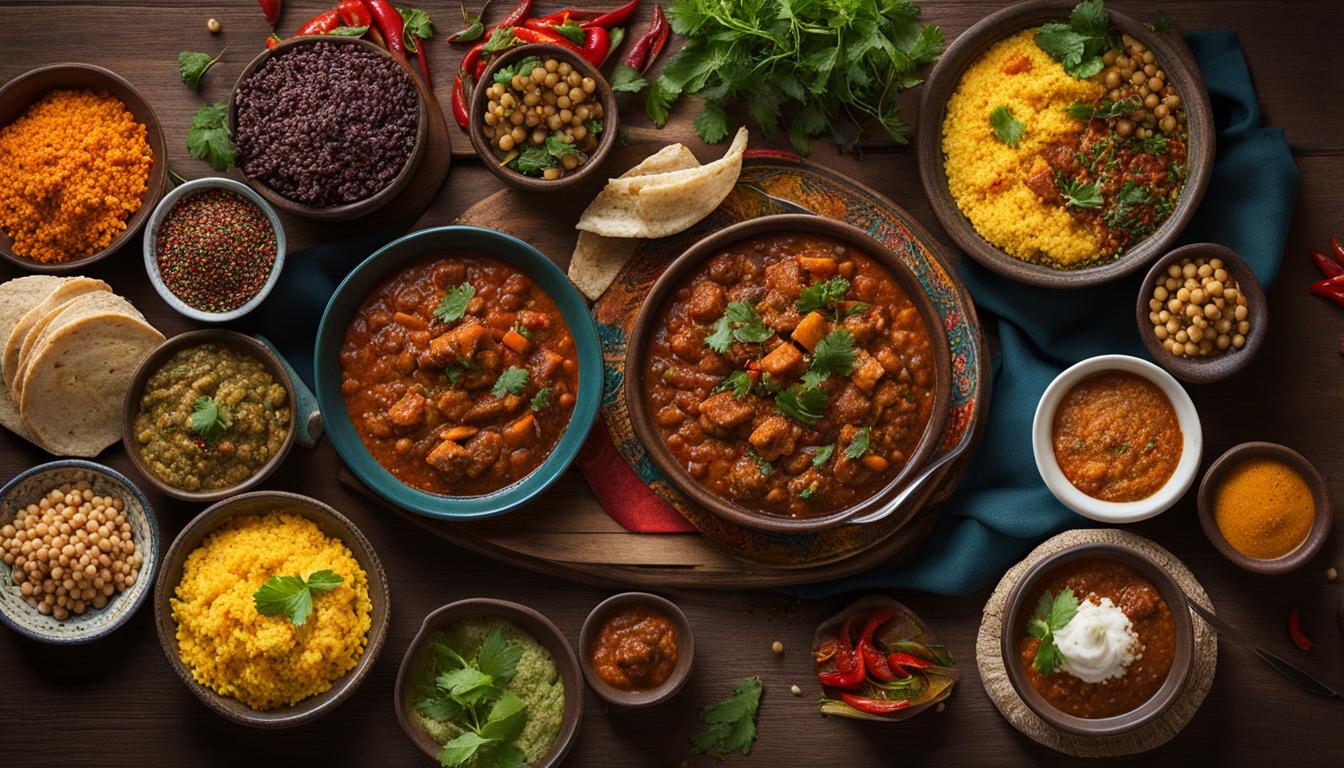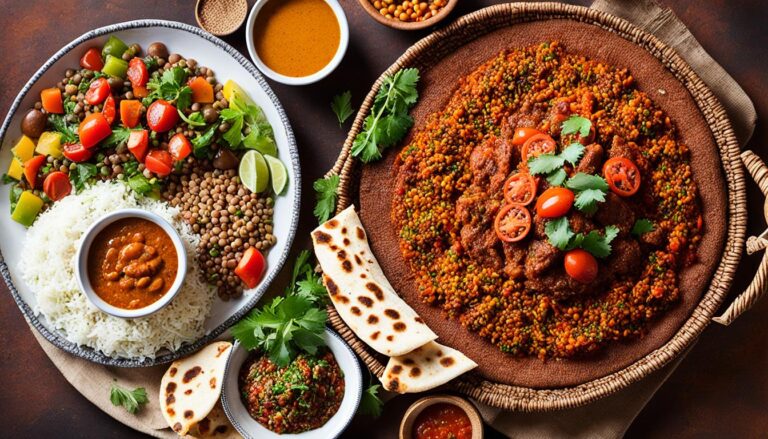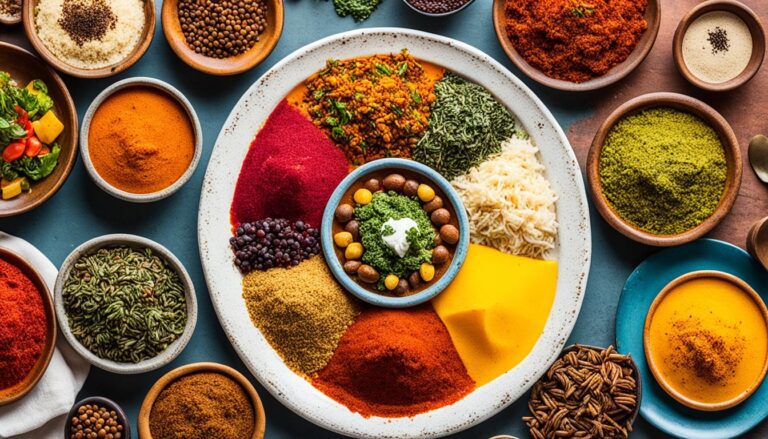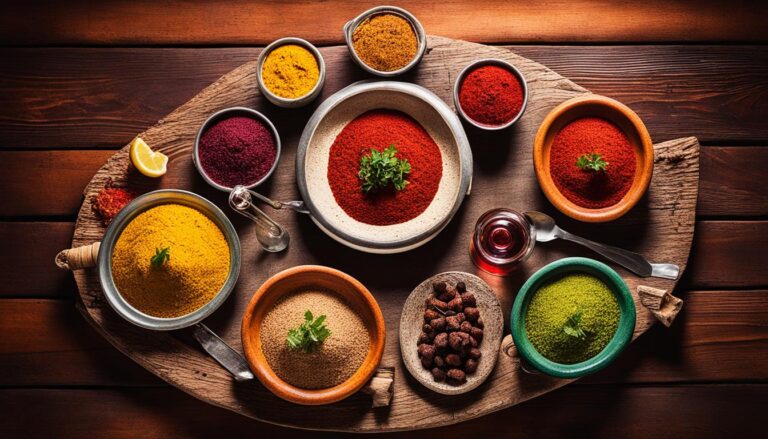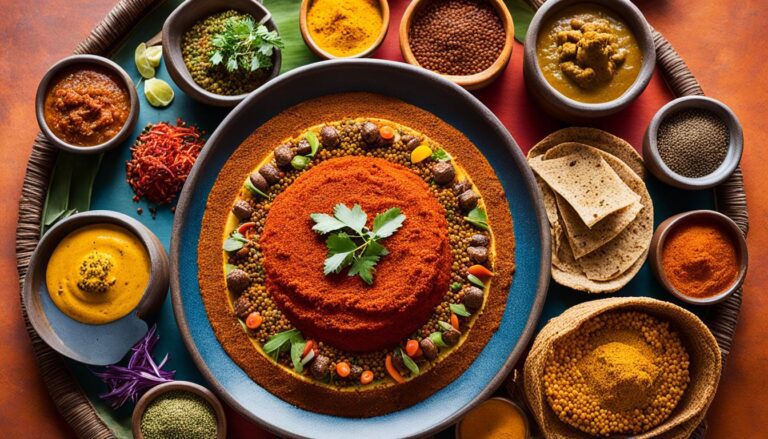Does Ethiopian Food Have Soy?
When it comes to exploring different cuisines, Ethiopian food never fails to captivate our taste buds. The rich flavors, aromatic spices, and diverse ingredients create a culinary experience like no other. But have you ever wondered if Ethiopian cuisine incorporates soy? Is this versatile legume a prominent component of traditional Ethiopian dishes? Let’s dive deeper into the world of Ethiopian food and unravel the mystery surrounding soy’s presence.
Key Takeaways:
- Ethiopian cuisine is known for its unique flavors, spices, and ingredients.
- We will explore traditional Ethiopian dishes like injera, doro wat, kitfo, and shiro to determine if soy is commonly used.
- Whether you follow a vegetarian, vegan, or gluten-free diet, Ethiopian food can cater to your dietary preferences.
- Stay tuned to discover if soy plays a significant role in the vibrant world of Ethiopian cuisine.
Understanding Ethiopian Cuisine
Before we explore the presence of soy in Ethiopian food, let’s delve into the rich and vibrant world of Ethiopian cuisine. Ethiopian food is known for its unique flavors, aromatic spices, and diverse range of ingredients, which come together to create a truly unforgettable dining experience.
When it comes to Ethiopian cuisine, flavors play a central role in defining the dishes. From the fiery heat of berbere spice blend to the tangy zest of lemon and lime, Ethiopian flavors are bold, complex, and utterly delicious.
Spices are another crucial element in Ethiopian cooking. The aromatic blend of spices, such as cumin, coriander, cardamom, and cloves, adds depth and complexity to the dishes, tantalizing the taste buds and creating a symphony of flavors.
Prime Ingredients
The use of fresh, local ingredients is a hallmark of Ethiopian cuisine. Staple ingredients like teff, a gluten-free grain, play a vital role in traditional dishes like injera, a spongy flatbread that serves as the foundation for many Ethiopian meals.
Ethiopian cuisine also features an abundant use of legumes, such as lentils and chickpeas, which not only add a rich source of protein but also lend their distinct flavors to various stews and curries.
Meat lovers will find delight in Ethiopian dishes like doro wat, a flavorful chicken stew, and kitfo, a spiced minced raw or rare beef dish. These dishes showcase the diverse range of flavors and cooking techniques present in Ethiopian culinary traditions.
As we explore Ethiopian cuisine further, we’ll uncover the secrets behind traditional Ethiopian dishes and their compatibility with different dietary preferences. But for now, let’s revel in the tantalizing aromas and flavors that make Ethiopian food an experience like no other.
Traditional Ethiopian Dishes
When it comes to Ethiopian cuisine, there are several traditional dishes that are widely enjoyed and celebrated for their unique flavors and textures. Let’s take a closer look at some of these popular dishes:
Injera
Injera is a staple in Ethiopian cuisine and is often referred to as a sourdough-risen flatbread. Made from teff flour, it has a distinctive spongy texture and a slightly tangy flavor. Injera serves as the foundation of many Ethiopian meals, serving as both a plate and utensil. It is typically used to scoop up other dishes, such as stews, and is an integral part of the Ethiopian dining experience.
Doro Wat
Doro Wat is a flavorful chicken stew that is considered one of Ethiopia’s national dishes. It is made with chicken, onions, garlic, ginger, and a blend of spices such as berbere, a traditional Ethiopian spice mix. Doro Wat is often served with injera and can be enjoyed at both casual and formal dining occasions.
Kitfo
Kitfo is a popular Ethiopian dish made from finely minced raw beef. It is typically seasoned with spices and served with injera or bread. Kitfo can be enjoyed in different variations, including a cooked version where the meat is lightly sautéed, or tartare-style, mixed with spices and served raw. This dish is often enjoyed with a side of cottage cheese and vegetables.
Shiro
Shiro is a flavorful Ethiopian stew made from ground lentils or chickpeas. It is seasoned with various spices and often enjoyed as a vegetarian or vegan option. Shiro is typically served with injera and can be customized with additional ingredients such as onions, garlic, and tomato paste to enhance its taste.
These traditional Ethiopian dishes showcase the rich and diverse flavors of Ethiopian cuisine. From the sourdough flatbread of injera to the aromatic spices found in doro wat, kitfo, and shiro, Ethiopian cuisine offers a delightful culinary experience that showcases the country’s vibrant culture and culinary heritage.
Dietary Preferences and Ethiopian Food
When it comes to enjoying delicious cuisine, dietary preferences should never feel limiting. That’s why Ethiopian food is an excellent choice for those following vegetarian, vegan, or gluten-free diets. Ethiopian cuisine offers a diverse range of flavorful dishes that cater to various dietary restrictions, ensuring everyone can savor the taste of Ethiopia without compromise.
For vegetarians, Ethiopian cuisine shines with its abundance of plant-based options. From beautifully spiced lentils to vibrant vegetable stews, you’ll find a plethora of vegetarian-friendly dishes that highlight the rich flavors and textures of Ethiopian cooking. One of the staples in Ethiopian cuisine is injera, a sourdough flatbread made from fermented teff flour that is naturally gluten-free and pairs perfectly with the vegetable-heavy dishes.
Vegans will also find plenty to enjoy in Ethiopian food. In traditional Ethiopian recipes, meat is often used as a flavor enhancer rather than the main component of the dish. This means that many traditional Ethiopian dishes can easily be adapted to be vegan-friendly by omitting the meat and focusing on the aromatic spices and vegetables that create the distinctive flavors of Ethiopian cuisine.
Those following a gluten-free diet can also indulge in the flavors of Ethiopian food without worry. As mentioned earlier, injera is a gluten-free flatbread made from teff flour, which is naturally free from gluten. This makes injera a versatile and satisfying gluten-free option that serves as a base for many Ethiopian dishes. Additionally, many traditional Ethiopian dishes rely on naturally gluten-free ingredients like lentils, chickpeas, and vegetables, ensuring a variety of gluten-free options for those with dietary restrictions.
So, whether you’re a vegetarian, vegan, or adhering to a gluten-free diet, Ethiopian cuisine has got you covered. With its vibrant flavors, aromatic spices, and diverse array of plant-based options, Ethiopian food offers a delightful dining experience that takes into account your dietary preferences without compromising on taste or authenticity.
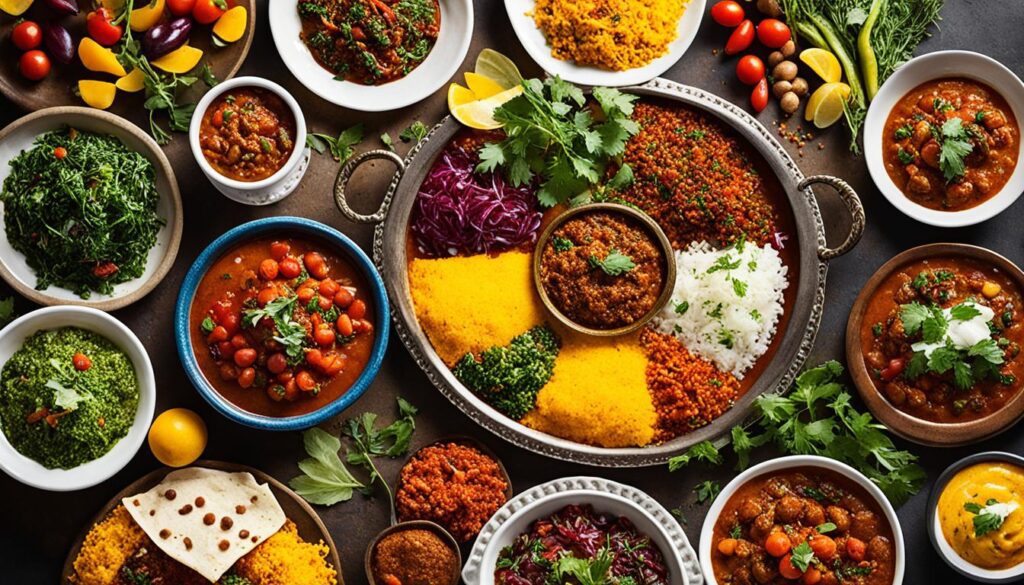
Experience the flavors of Ethiopia and embark on a culinary journey that caters to your dietary needs. Let the bold spices and colorful dishes of Ethiopian cuisine tantalize your taste buds, opening up a world of possibilities for those with diverse dietary preferences.
Conclusion
In our exploration of Ethiopian cuisine, we have investigated the presence of soy in traditional Ethiopian dishes. While soy is not a commonly used ingredient in Ethiopian food, it is important to note that Ethiopian cuisine offers a diverse range of flavors and ingredients that cater to different dietary preferences.
Through our analysis of Ethiopian flavors and spices, we have discovered that the use of unique herbs and spices like berbere, niter kibbeh, and mitmita is central to Ethiopian cuisine. These flavors contribute to the rich taste and complexity of traditional Ethiopian dishes without relying on soy as a prominent ingredient.
Additionally, we have found that Ethiopian cuisine provides ample options for individuals with dietary restrictions. Whether you follow a vegetarian, vegan, or gluten-free diet, Ethiopian food offers a variety of plant-based dishes and gluten-free options that can be enjoyed with or without the inclusion of soy.
In conclusion, while soy is not a prevalent ingredient in Ethiopian cuisine, the flavors and ingredients present in traditional Ethiopian dishes provide a unique and satisfying dining experience. So, whether you’re seeking a soy-free meal or looking to explore the vibrant flavors of Ethiopian cuisine, there are plenty of options to indulge in the delicious culinary offerings of Ethiopia.

